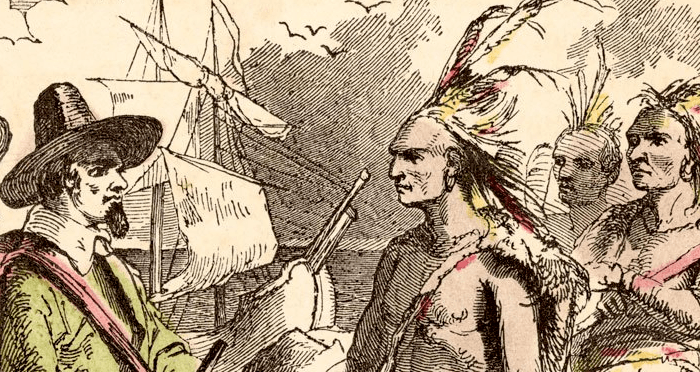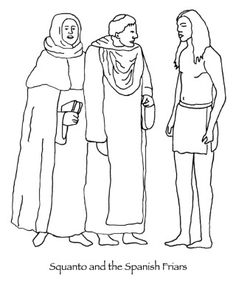
Native American groups who had managed to survive the epidemic. Unfortunately, these tribes found it difficult to defend themselves against the Narragansetts and other hostile The few surviving Native Americans banded together into smaller tribes. Squanto returned in 1619 to find the village of his youth abandoned. The Patuxet band, for instance, was virtually wiped out. Because the Native Americans had no immunity (built-in resistance) against European diseases, a majority of them died. In 1617, during Squanto's absence, a great epidemic (perhaps the plague) swept the Massachusetts Bay region. In any event, he traveled once again to the New World with Dermer in 1619, this time returning to the Patuxet region of his birth. In serving both Slaney and Dermer, Squanto may have hoped to earn his passage home. Squanto may have been an indentured servant (a servant who works for a certain length of time in order to buy his or her freedom) during this time rather than a slave (one who is owned by a master). There Squanto met explorer Thomas Dermer, and the two men returned to England the following year. In 1617 Slaney sent him on an expedition to New Foundland.

There he resided with John Slaney, the treasurer of the New Foundland Company, who was interested in exploring the New World.ĭuring his time in London, Squanto was immersed in English culture and learned the English language. While historians are uncertain about Squanto's movements over the next three years, he is known to have arrived in London, England, in 1617. Squanto, however, was rescued by Spanish friars (members of a religious order who combine life as a monk with outside religious activity) who wanted to convert the Native Americans to Christianity. Taking his captives to Málaga, Spain, Hunt sold them into slavery. During that year, he and twenty other Patuxets were kidnaped by English explorer Thomas Hunt. In 1614 Squanto's life was dramatically changed. At the time Squanto apparently held the prominent position of chief of the Patuxet tribe. As a result of this frequent contact, the Patuxets engaged in trade with the constant traffic of traders and explorers. In fact, French explorer Samuel de Champlain (see entry) provided extensive documents of his visits in 16. During Squanto's lifetime this area was visited by European He was a member of the Patuxet band of the Wampanoag tribe, which dominated the region. Squanto was born around 1600 in Patuxet, a village of about two thousand Native Americans located in what is now Plymouth Bay, Massachusetts. Squanto is nevertheless considered to be the person who did more than anyone else to secure the survival of the Plymouth Colony settlers. Controversy surrounds Squanto's life because of his attempts to undermine Massasoit's authority. Squanto was overshadowed, however, by the Pokanoket chief Massasoit (see entry), who is famous for establishing a peace treaty with the Pilgrims in 1621. He is remembered as the interpreter, guide, and agricultural advisor who shepherded the English settlers of Plymouth Colony through their unstable early existence in the New World (a European term for North America and South America). Squanto, also known as Tasquantum (or Tisquantum), was a major seventeenth-century Native American figure.

Plymouth Colony governor William Bradford. "Squanto continued with them and was their interpreter, and as a special instrument sent of God for their good beyond their expectation."


 0 kommentar(er)
0 kommentar(er)
